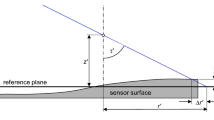Abstract
This paper has been prompted by observations of some anomalies in the performance of the standard imaging models (pin-hole, thin-lens and Gaussian thick-lens), in the context of composing omnifocus images and estimating depth maps from a sequence of images. A closer examination of the models revealed that they assume a position of the aperture that conflicts with the designs of many available lenses. We have shown in this paper that the imaging geometry and photometric properties of an image are significantly influenced by the position of the aperture. This is confirmed by the discrepancies between observed mappings and those predicted by the models. We have therefore concluded that the current imaging models do not adequately represent practical imaging systems. We have proposed a pupil-centric model of image formation, which overcomes these deficiencies and have given the associated mappings. The impact of this model on some common imaging scenariosis described, along with experimental verification of the better performance of the model on three real lenses.
Similar content being viewed by others
References
Aggarwal, M. and Ahuja, N. 2000. Camera center estimation. In International Conference on Pattern Recognition, pp. 876–880.
Aggarwal, M., Hua, H., and Ahuja, N. 2001. On cosine-fourth and vignetting effects in real lenses. In International Conference on Computer Vision, Vol. 2., pp. 472–479.
Castano, A. 1998. Range from non-frontal imaging camera. Ph.D. Thesis, University of Illinois at Urbana-Champaign.
Faugeras, O.D. 1995. Stratification of the three-dimensional vision: Projective, affine, and metric representations. Journal of Optical Society of America A., 12(3): 465–484.
Forsyth, D. and Ponce, J. 2000. Computer Vision-A Modern Approach. In preparation, draft 3, www.cs.berkeley.edu/ daf.
Hecht, E. and Zajac, A. 1974. Optics. Addison Wesley: Reading, MA.
Horn, B.K.P. 1986. Robot Vision. The MIT Press: Cambridge, Mass.
Kingslake, R. 1978. Lens Design Fundamantals. Academic Press: San Mateo, CA.
Kingslake, R. 1983. Optical System Design. Academic Press: San Mateo, CA.
Kolb, C., Mitchell, D., and Hanrahan, P. 1995. A realistic camera model for computer graphics. In Proceedings of SIGGGRAPH, pp. 317–324.
Krishnan, A. 1997. Non-frontal imaging camera. Ph.D. Thesis, University of Illinois at Urbana-Champaign.
Krishnan, A. and Ahuja, N. 1996. Range estimation from focus using a non-frontal imaging camera. International Journal of Computer Vision, 20(3): 169–185.
Smith, W.J. 1992. Modern Lens Design-A Resource Manual. McGraw Hill: New York.
Triggs, B. 1998. Autocalibration from planar scenes. In European Conference on Computer Vision, Vol. 1., pp. 89–105.
Tsai, R.R. 1986. An efficient and accurate camera calibration tech-nique for 3D machine vision. In Conference on Computer Vision and Pattern Recognition, pp. 364–374.
Tsai, R.Y. 1987. A versatile camera calibration technique for high-accuracy 3D machine vision metrology using off-the shelf TV cameras and lenses. IEEE Journal of Robotics and Automation, RA-3(4): 323–344.
Watanabe, M. and Nayar, S.K. 1997. Telecentric optics for focus analysis. IEEE Transactions on Pattern Analysis and Machine Intelligence, 19(12): 1360–1365.
Zhang, Z. 2000. A flexible new technique for camera calibration. IEEE Transactions on Pattern Analysis and Machine Intelligence, 22(11): 1330–1334.
Author information
Authors and Affiliations
Rights and permissions
About this article
Cite this article
Aggarwal, M., Ahuja, N. A Pupil-Centric Model of Image Formation. International Journal of Computer Vision 48, 195–214 (2002). https://doi.org/10.1023/A:1016324132583
Issue Date:
DOI: https://doi.org/10.1023/A:1016324132583




